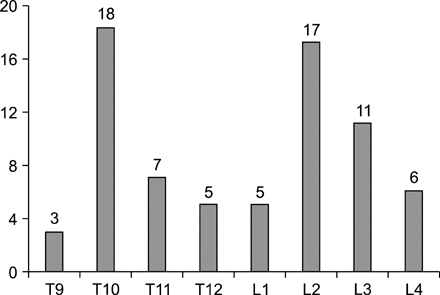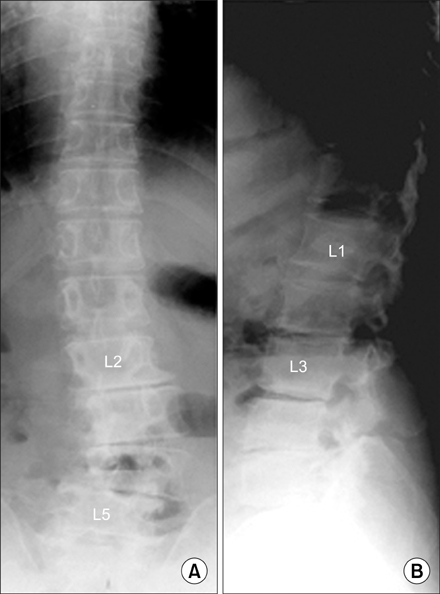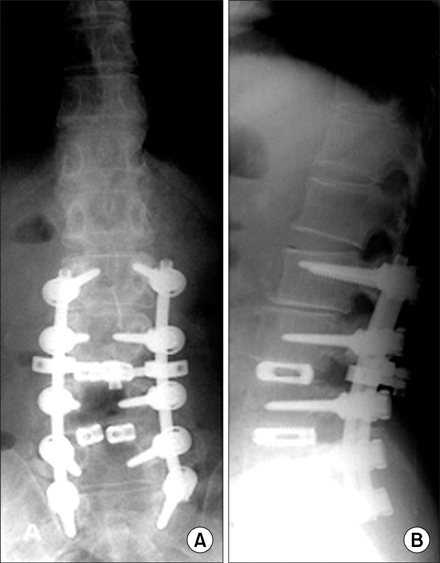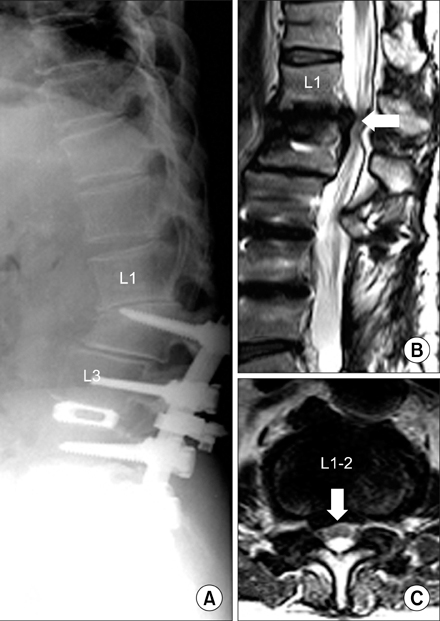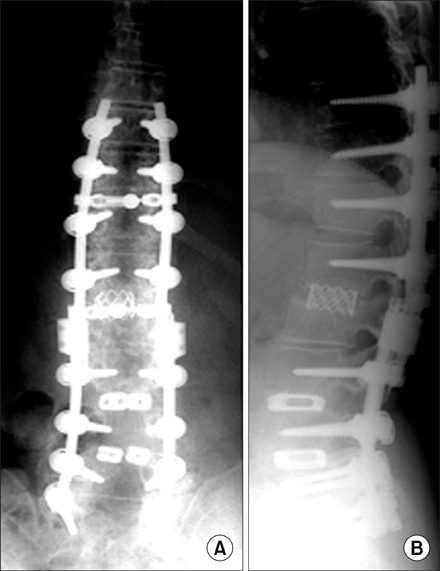J Korean Orthop Assoc.
2009 Feb;44(1):109-117. 10.4055/jkoa.2009.44.1.109.
Proximal Adjacent Segment Disease following Posterior Instrumentation and Fusion for Degenerative Lumbar Scoliosis
- Affiliations
-
- 1Department of Orthopedic Surgery, Inha University College of Medicine, Incheon, Korea. srp2002@inha.com
- 2Department of Orthopedic Surgery, Seoul Spine Institute, Inje University Hospital, Seoul, Korea.
- KMID: 2186385
- DOI: http://doi.org/10.4055/jkoa.2009.44.1.109
Abstract
- PURPOSE
Adjacent segment disease (ASD) is major complication following spinal instrumentation and fusion. The purpose of the current study was to determine the prevalence and risk factors of proximal ASD following posterior instrumentation and fusion for degenerative lumbar scoliosis.
MATERIALS AND METHODS
Seventy-two patients (mean age 64.8 years) who had undergone decompression and fusion with pedicle screw instrumentation were evaluated. The average follow-up was 4.7 years. Twenty-five patients had additional interbody fusion at the lower lumbar spine. The average number of levels fused was 5.1 segments (range 1-9). The upper instrumented vertebrae ranged from T9 to L4. The lower instrumented vertebrae were L5 and S1.
RESULTS
Proximal ASD developed in 17 (24%) of 72 patients, including compression fractures (n=6), junctional kyphosis (n=5), spinal stenosis (n=4), and symptomatic disc collapse (n=2). The preoperative scoliotic angle, lumbar lordosis, thoracic kyphosis, and coronal and sagittal C7 plumb were not associated with the development of proximal ASD. There was a close correlation between the level of the upper instrumented vertebrae and the development of ASD (p=0.001). When fusion did not extend beyond the lumbar vertebra, ASD occurred in 15 (38.5%) of 39 patients. In contrast, when fusion extended up to the thoracic vertebrae, ASD occurred in 2 (6.1%) of 33 patients. The improvement in the Oswestry score was superior to the group without ASD (p=0.001).
CONCLUSION
The prevalence of symptomatic ASD at the proximal segment was 24% after posterior instrumentation and fusion for degenerative lumbar scoliosis. The cephalad extent of fusion was the most significant risk factor for the development of proximal ASD.
MeSH Terms
Figure
Cited by 2 articles
-
Correlation of Adjacent Segmental Disease with Tilt Angles of the Upper and Lower Instrumented Vertebra in the Degenerative Lumbar Scoliosis
Jun-Young Yang, June-Kyu Lee, Yong-Bum Joo, Soo-Min Cha, Jun-Yeong Park
J Korean Soc Spine Surg. 2013;20(1):1-7. doi: 10.4184/JKSS.2021.20.1.1.Changes in the Adjacent Segment After Thoracolumbar Posterior Instrumentation and Fusion Surgery in Thoracolumbar Junction Fractures
Tae-Keun Ahn, Tae-Ho Kim, Sang-Jun Lee, Chul-Gie Hong, Dong-Eun Shin, Youngsuk Sim
J Korean Soc Spine Surg. 2017;24(3):147-152. doi: 10.4184/jkss.2017.24.3.147.
Reference
-
1. Ahn DK, Lee S, Jeong KW, Park JS, Cha SK, Park HS. Adjacent segment failure after lumbar spine fusion-controlled study for risk factors. J Korean Orthop Assoc. 2005. 40:203–208.2. Booth KC, Bridwell KH, Eisenberg BA, Baldus CR, Lenke LG. Minimum 5-Year results of degenerative spondylolisthesis treated with decompression and instrumented posterior fusion. Spine. 1999. 24:1721–1727.
Article3. Cho JL, Park YS, Han JH, Lee CH, Roh WI. The changes of adjacent segments after spinal fusion: follow-up more than three years after spinal fusion. J Korean Spine Surg. 1998. 5:239–246.4. Cho KJ, Park SR, Moon KH, et al. Progression of preoperative degeneration of the adjacent segment after instrumented lumbar arthrodesis. J Korean Orthop Assoc. 2007. 42:453–460.
Article5. Epstein JA, Epstein BS, Jones MD. Symptomatic lumbar scoliosis with degenerative changes in the elderly. Spine. 1979. 4:542–547.
Article6. Etebar S, Cahill DW. Risk factors for adjacent-segment failure following lumbar fixation with rigid instrumentation for degenerative instability. J Neurosurg. 1999. 90:Suppl 2. S163–S169.
Article7. Ghiselli G, Wang JC, Bhatia NN, Hsu WK, Dawson EG. Adjacent segment degeneration in the lumbar spine. J Bone Joint Surg Am. 2004. 7:1497–1503.
Article8. Gillet P. The fate of the adjacent motion segment after lumbar fusion. J Spinal Disord Tech. 2003. 16:338–345.9. Grubb SA, Lipscomb HJ. Diagnostic findings in painful adult scoliosis. Spine. 1992. 17:518–527.
Article10. Ha KY, Kim KW, Park SJ, Lee YH. Changes of the adjacent-unfused mobile segment after instrumental lumbar fusion: more than 5-years follow-up. J Korean Spine Surg. 1998. 5:205–214.11. Herkowitz HN, Kurz LT. Degenerative lumbar spondylolisthesis with spinal stenosis. A prospective study comparing decompression with decompression and intertransverse process arthrosis. J Bone Joint Surg Am. 1991. 73:802–808.12. Hilibrand AS, Robbins M. Adjacent segment degeneration and adjacent segment disease: the consequences of spinal fusion? Spine. 2004. 4:Suppl 6. S190–S194.
Article13. Hsu KY, Zucherman J, White AH, editors. Deterioration of motion segments adjacent to lumbar spine fusions. Presented at the Annual Meeting of the North American Spine Society. 1988. Colorado Springs, Colorado.14. Kanayama M, Cunningham BW, Weis JC, Parker LM, Kaneda K, McAfee PC. Maturation of the posterolateral spinal fusion and its effect on load-sharing of spinal instrumentation. An in vivo sheep model. J Bone Joint Surg Am. 1997. 79:1710–1720.15. Kumar MN, Baklanov A, Chopin D. Correlation between sagittal plane changes and adjacent segment degeneration following lumbar spine fusion. Eur Spine J. 2001. 10:314–319.16. Kumar MN, Jacpuot F, Hall H. Long-term follow-up of functional outcomes and radiographic changes at adjacent levels following lumbar spine surgery for degenerative disc disease. Eur Spine J. 2001. 10:309–313.17. Lee CK. Lumbar spinal instability (olisthesis) after extensive posterior spinal decompression. Spine. 1983. 8:429–433.
Article18. Lehmann TR, Spratt KF, Tozzi JE, et al. Long-term follow-up of lower lumbar fusion patients. Spine. 1987. 12:97–104.
Article19. Mardjetko SM, Connolly PJ, Shott S. Degenerative lumbar spondylolisthesis. A meta-analysis of literature 1970-1993. Spine. 1994. 15:Suppl 20. S2256–S2265.20. Park P, Garton HJ, Gala MVC, Hoff JT, McGillicuddy JE. Adjacent segment disease after lumbar or lumbosacral fusion: review of the literature. Spine. 2004. 29:1938–1944.
Article21. Penta M, Sandhu A, Fraser RD. Magnetic resonance imaging assessment of disc degeneration 10 years after anterior lumbar interbody fusion. Spine. 1995. 20:743–747.
Article22. Quinnel RC, Stockdale HR. Some experimental observations of the influence of a single lumbar floating fusion on the remaining lumbar spine. Spine. 1981. 6:263–267.
Article23. Rohlman A, Neller S, Bergmann G, Graichen F, Claes L, Wilke HJ. Effect of an internal fixator and a bone graft on intersegmental spinal motion and intradiscal pressure in the adjacent regions. Eur Spine J. 2001. 10:301–308.
Article24. Schlegel JD, Smith JA, Schleusener RL. Lumbar motion segment pathology adjacent to thoracolumbar, lumbar, and lumbosacral fusions. Spine. 1996. 21:970–981.
Article25. Shufflebarger H, Suk SI, Mardjetko S. Debate: determining the upper instrumented vertebra in the management of adult degenerative scoliosis: stopping at T10 versus L1. Spine. 2006. 31:Suppl 19. S185–S194.26. Simmons ED Jr, Simmons EH. Spinal stenosis with scoliosis. Spine. 1992. 17:Suppl 6. S117–S120.
Article27. Weinhofter SL, Guyer RD, Herbert M, Griffith SL. Intradiscal pressure measurements above an instrumented fusion. A cadaveric study. Spine. 1995. 20:526–531.28. Yang SH, Chen PQ. Proximal kyphosis after short posterior fusion for thoracolumbar scoliosis. Clin Orthop. 2003. 411:152–158.
Article
- Full Text Links
- Actions
-
Cited
- CITED
-
- Close
- Share
- Similar articles
-
- Correlation of Adjacent Segmental Disease with Tilt Angles of the Upper and Lower Instrumented Vertebra in the Degenerative Lumbar Scoliosis
- Progression of Preoperative Degeneration of the Adjacent Segmentafter Instrumented Lumbar Arthrodesis
- The Causes of Revision Arthrodesis for the Degenerative Changes at the Adjacent Segment after Lumbosacral Fusion for Degenerative Lumbar Diseases
- Revision Arthrodesis After Lumbar Fusion in Degenerative Lumbar Disease
- Comparison of Short Fusion versus Long Fusion for Degenerative Lumbar Scoliosis

